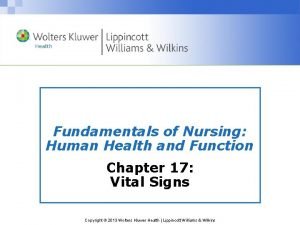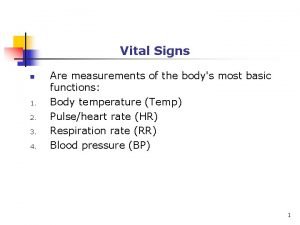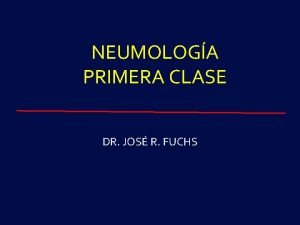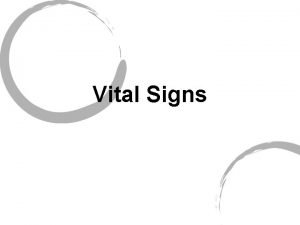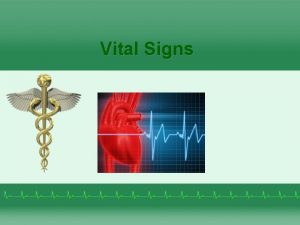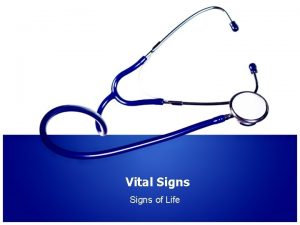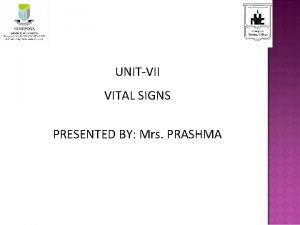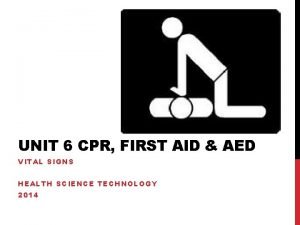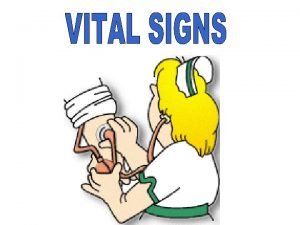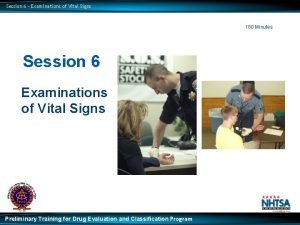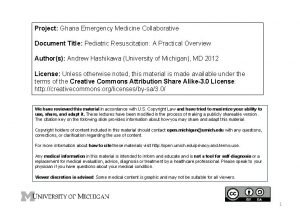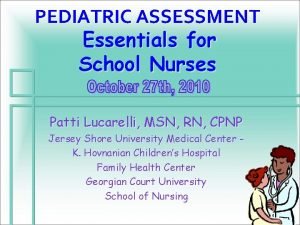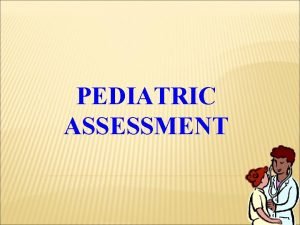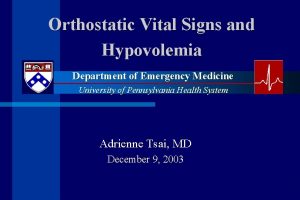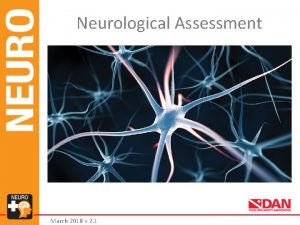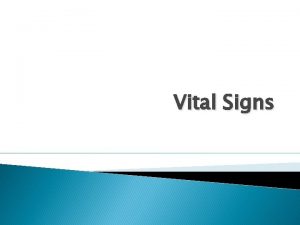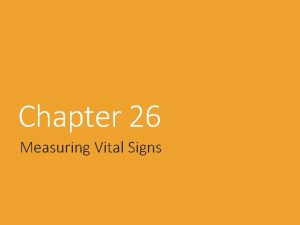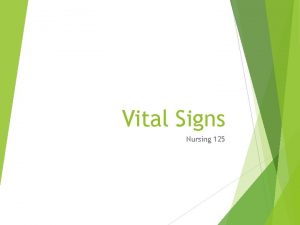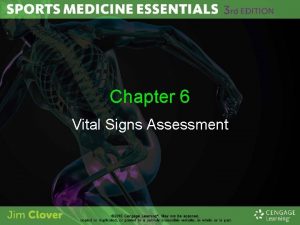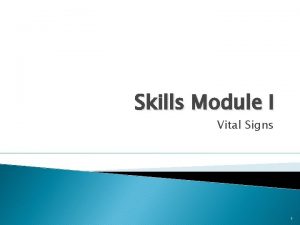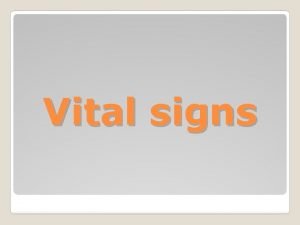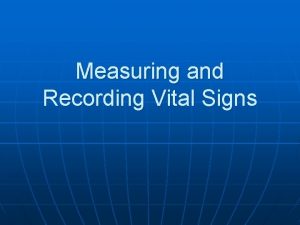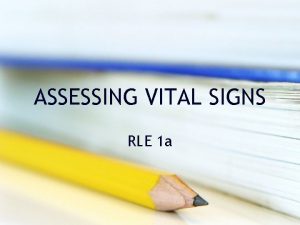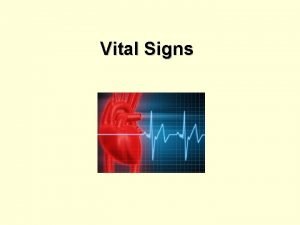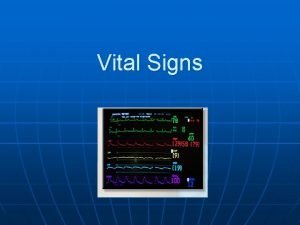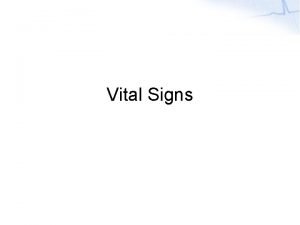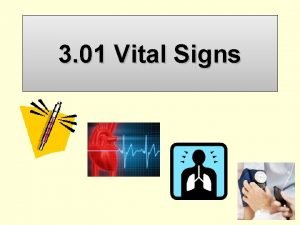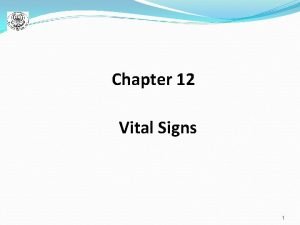Vital Signs Practical Nursing Assessment Techniques Module Vital
























- Slides: 24

Vital Signs Practical Nursing Assessment Techniques Module

Vital Signs n n n Measurement of various basic body conditions which provide information about a patients condition. Homeostasis is the ideal state of health and fluid balance in which all body systems are functioning within normal limits Deviations in any of vital sign from the normal range is often the first indicator of a problem in a patient.

Vital Signs Temperature Pulse Respiration Blood Pressure Pain SP 02

Temperature n Measurement of balance of heat lost & heat produced n n Heat lost through perspiration, respiration and excretion Heat produced by metabolism as well as muscle & gland activity Low or High reading can be indication of disease process Measured in Fahrenheit or Celsius Normal Adult Temperature Ranges Axillary 97. 6 96. 6 to 98. 6 Oral & Tympanic 98. 6 97. 6 to 99. 6 Rectal 99. 6 98. 6 to 100. 6

Factors Influencing Temperature Time of day n Part of body where temperature taken n Illness, infection exercise, excitement, high environmental temperatures n Starvation, sleep, oral breathing, exposure to cold temperatures, certain illnesses n Recent ingestion of food, drink or smoking n

Temperature Sites n n n Oral Axillary Rectal Aural Temporal n n n Mouth Under the armpit In the rectum In the ear Across the forehead When charting a temperature, you must indicate on your notes if the temperature is taken someplace other than the mouth. In other words, it is assumed the recorded temperature is oral unless otherwise stated.

Important Factors to Consider When the patient last had something to eat or drink n When the patient last smoked n Is the patient a mouth breather n Whether or not the axilla or skin is dry n Are there contraindications for rectal use of thermometer n

Pulse n Defined as the pressure of the blood pushing against the wall of an artery caused by contracting of the heart muscles

Pulse Sites n n n n Radial Carotid Brachial Apical Temporal Femoral Popliteal Pedal

Normal Ranges Normal range vary depending on sex, age, body size n Normal adult range 60 – 90 beats per minute n Children 80 – 110 n Infants 100 -160 n

Terms to Know Tachycardia – pulse rate over 100 (adults) n Bradycardia – Pulse rate less than 60 n Rhythm – refers to the regularity of the pulse – regular, irregular n Volume – refers to the strength of the pulse – strong, weak, thready, or bounding n

Factors Influencing the Pulse n Increased by: Exercise, stimulant drugs, excitement, fever, shock, nervous tension n Decreased by: sleep, depressant drugs, heart disease, coma, physical training

Apical Pulse n n n Taken with a stethoscope at the apex of the heart Counted for 1 full minute Pulse deficit occurs when there is a difference between apical and radial pulses Most accurate way to check a pulse Each lubb-dubb counted as 1 beat


Respirations Process of taking in oxygen and expelling carbon dioxide from the lungs or One breath in (inspiration) and one breath out (expiration)

Respiratory Rates Normal adult respiratory rate is 14 – 20 wider range 12 – 24 breaths per minute n Children range from 16 – 25 n Infants range from 30 – 50 n Tachypnea = respiratory rates 25 or > n Bradypnea = respiratory rate > 12 n

Respiratory Terms Character = deep, shallow, labored, difficult n Rhythm = regular, irregular n Dyspnea = difficult or labored breathing n Apnea = absence of respirations n Orthopnea = must sit or stand to breath n Cheyne Stokes = periods of dyspnea followed by apnea n

Pulse & Respiration n n Count each for 1 full minute initially Respirations partially under voluntary control, so do not let patient know you are counting respirations Count pulse 1 st, without removing hands, count respirations After it is established the patient has a regular pulse, count can be decreased to 30 sec.

Blood Pressure Measurement of the pressure that exerts on the walls of the arteries during various stages of heart activity n Systolic pressure occurs during the contracting phase (1 st sound) n Diastolic pressure occurs during the resting phase (last sound) n

Normal Blood Pressure Ranges Systolic pressure 90 – 140 n Diastolic Pressure 60 – 90 n Systolic pressures > 140 or Diastolic pressures > 90 = Hypertension n Systolic pressure < 90 or Diastolic pressure < 60 = Hypotension n New guidelines indicate prehypertension rates of 120 -140 systolic and 80 -90 diastolic n

Factors Influencing Blood Pressure n Factors increasing Blood Pressure include excitement, anxiety, nervous tension, stimulant drugs, exercise and eating n Factors decreasing blood pressure include rest or sleep, depressant drugs, shock, excessive blood loss n Blood pressure can vary from sitting, standing and lying positions

Terms Pertaining to Blood Pressure n n n Sphygmomanometer – instrument used to measure blood pressure Aneroid Gauge – Round gauge – each line represents 2 Mercury gauges are vertical and may still be used in some facilities – each vertical line represents 2 Electronic sphygmomanometers also available Always remember never trust your monitors – when in doubt check it manually

PAIN Assessment of pain should include: • Location – does it radiate • Intensity – best to assess with a scale. • Character – is it sharp, dull, throbbing, burning • Onset/Duration – when did it start, how long does it last Considered to be the 5 th Vital Sign

Summary Vital signs are single most important indicator of optimal or abnormal state of health n Accuracy is essential when measuring vital signs n Vital signs are often delegated, but delegating a skill to someone else does not release the nurse from responsibility. n
 Sign shapes meaning
Sign shapes meaning Fundamentals of nursing chapter 17 vital signs
Fundamentals of nursing chapter 17 vital signs What are the 8 vital signs?
What are the 8 vital signs? Radial pulse normal range
Radial pulse normal range Capacidad vital y capacidad vital forzada
Capacidad vital y capacidad vital forzada Vital signs
Vital signs What are the 8 vital signs?
What are the 8 vital signs? Apical pulse
Apical pulse Vital signs defintion
Vital signs defintion Vital signs normal range for pediatrics
Vital signs normal range for pediatrics Summary of vital signs
Summary of vital signs What are the 8 vital signs?
What are the 8 vital signs? Guidelines for measuring vital signs
Guidelines for measuring vital signs Vital signs ranges
Vital signs ranges Vital signs conclusion
Vital signs conclusion 6 vital signs first aid
6 vital signs first aid Graphing tpr
Graphing tpr Normal vitals for adults
Normal vitals for adults 6 vital signs
6 vital signs Pediatric vitals
Pediatric vitals Normal vital signs
Normal vital signs Pedia vital signs
Pedia vital signs Positive orthostatic vital signs
Positive orthostatic vital signs Orthostatic vitals definition
Orthostatic vitals definition Neuro vital signs meaning
Neuro vital signs meaning

